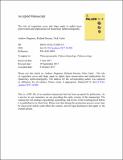The role of vegetation cover and slope angle in tephra layer preservation and implications for Quaternary tephrostratigraphy
Abstract
Our aim is to understand the significance of slope position, slope angle and the interplay between slopes and vegetation in influencing the ways in which tephra layers may be preserved, thickened or thinned within the Quaternary stratigraphic record. This matters because tephra layers are used to reconstruct volumes of past volcanic eruptions and assess both past and future risks, hazards and impacts. This study uses modern data to better understand the formation of the palaeoenvironmental record and evaluates a data set of > 5500 tephra layer thickness measurements across a range of slopes and vegetation types in Iceland and Washington State, USA. We measured tephra layers formed in October 1918, March 1947, May 1980, April 2010 and May 2011 across moderate slopes (< 35°). Holding vegetation communities constant, location on slope had no systematic impact on mean tephra layer thickness. Holding slopes constant (< 5°), we observed systematic modifications of initial fallout thickness in areas of different vegetation types, with layers both thinning and thickening in areas of partial vegetation cover, and thickening within taller vegetation. This has implications for the interpretation of Quaternary environmental record and the reconstruction of past volcanic fallout across areas of varied relief and strong vegetation gradients, where vegetation structure is patchy and topography is variable. Sloping sites with a consistent vegetation cover may produce the most reliable stratigraphic records of fallout whereas flat sites with varied vegetation might not.
Citation
Dugmore , A , Streeter , R & Cutler , N 2018 , ' The role of vegetation cover and slope angle in tephra layer preservation and implications for Quaternary tephrostratigraphy ' , Palaeogeography, Palaeoclimatology, Palaeoecology , vol. 489 , pp. 105-116 . https://doi.org/10.1016/j.palaeo.2017.10.002
Publication
Palaeogeography, Palaeoclimatology, Palaeoecology
Status
Peer reviewed
ISSN
0031-0182Type
Journal article
Description
Financial support was provided by the National Science Foundation of America, (through grant 1202692 ‘Comparative Island Ecodynamics in the North Atlantic’, and grant 1249313 ‘Tephra layers and early warning signals for critical transitions’), and the support of the Carnegie Trust for the Universities of Scotland.Collections
Items in the St Andrews Research Repository are protected by copyright, with all rights reserved, unless otherwise indicated.

